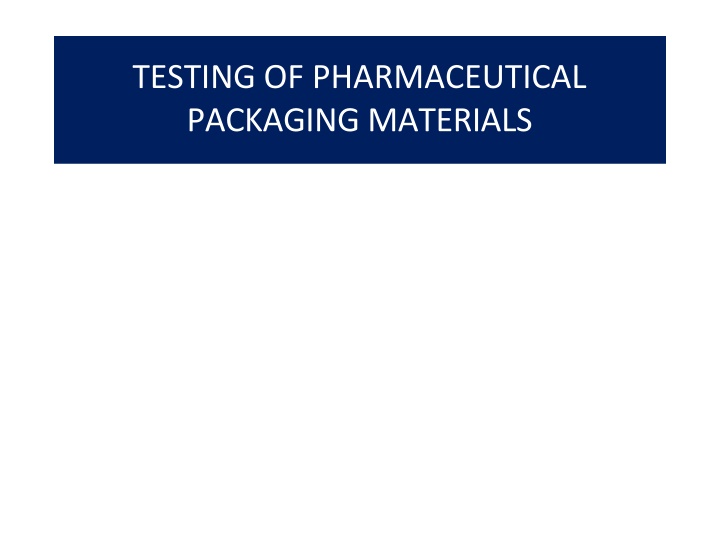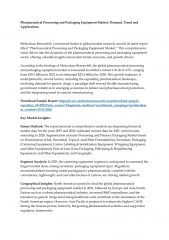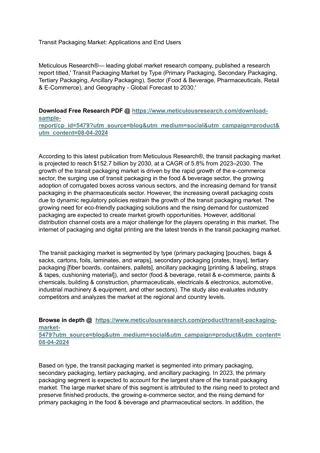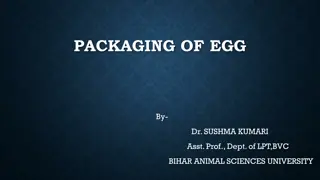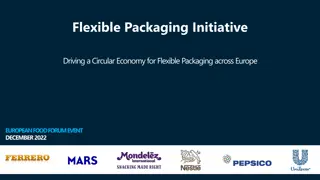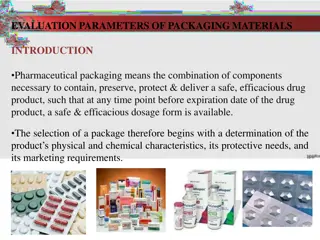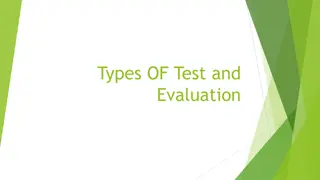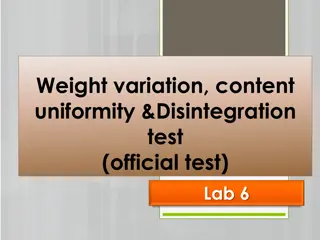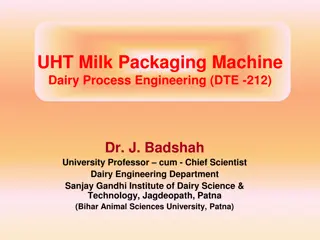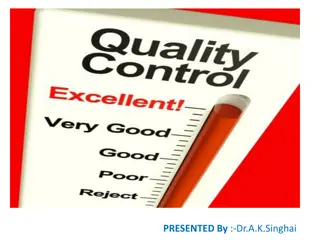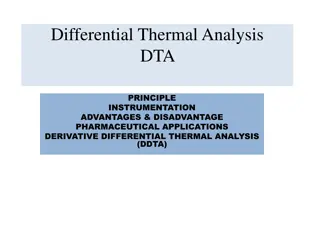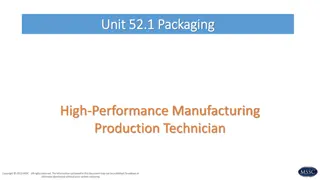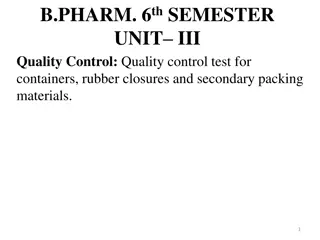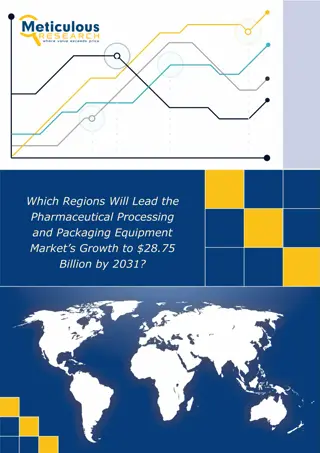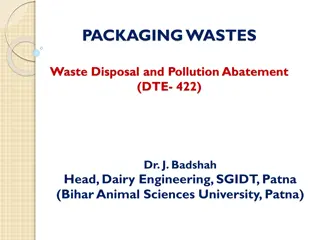Quality Control Tests for Pharmaceutical Packaging Materials
This article discusses quality control tests for pharmaceutical packaging materials focusing on glass containers. The tests include chemical resistant tests such as powdered glass test and water attack test, as well as hydrolytic resistance tests. Detailed procedures for each test are outlined along with the principles involved. The article emphasizes the importance of ensuring the quality and safety of pharmaceutical packaging materials through rigorous testing methods.
Download Presentation

Please find below an Image/Link to download the presentation.
The content on the website is provided AS IS for your information and personal use only. It may not be sold, licensed, or shared on other websites without obtaining consent from the author.If you encounter any issues during the download, it is possible that the publisher has removed the file from their server.
You are allowed to download the files provided on this website for personal or commercial use, subject to the condition that they are used lawfully. All files are the property of their respective owners.
The content on the website is provided AS IS for your information and personal use only. It may not be sold, licensed, or shared on other websites without obtaining consent from the author.
E N D
Presentation Transcript
TESTING OF PHARMACEUTICAL PACKAGING MATERIALS
QUALITY CONTROL TESTS FOR GLASSES 1) CHEMICAL RESISTANT OF GLASS CONTAINERS A)POWDERED GLASS TEST: It is done to estimate the amount of alkali leached from the powdered glass which usually happens at the elevated temperatures. When the glass is powdered, leaching of alkali is enhanced, which can be titrated with 0.02N sulphuric acid using methyl red as an indicator Step-1: Preparation of glass specimen: Few containers are rinsed thoroughly with purified water and dried with stream of clean air. Grind the containers in a mortar to a fine powder and pass through sieve no.20 and 50. Step-2: Washing the specimen: 10gm of the above specimen is taken into 250 ml conical flask and wash it with 30 ml acetone. Repeat the washing, decant the acetone and dried after which it is used within 48hr. Procedure: 10gm sample is added with 50ml of high purity water in a 250ml flask. Place it in an autoclave at 121 C 2 C for 30min.Cool it under running water. Decant the solution into another flask, wash again with 15ml high purity water and again decant. Titrate immediately with 0.02N sulphuric acid using methyl red as an indicator and record the volume. Packaging 2
B) WATER ATTACKTEST: This is only for treated soda lime glass containers under the controlled humidity conditions which neutralize the surface alkali and glass will become chemically more resistant. Principle involved is whether the alkali leached or not from the surface of the container. Procedure: Rinse thoroughly with high purity water. Fill each container to 90%of its overflow capacity with water and is autoclaved at 121 C for 30min then it is cooled and the liquid is decanted which is titrated with 0.02N sulphuric acid using methyl red as an indicator. The volume of sulfuric acid consumed is the measure of the amount of alkaline oxides present in the glass containers. TESTS CONTAINER VOL.OF 0.02N H2SO4 Powdered glass test Type I Type II Type III 1.0 8.5 15.0 Water attack test Type II(100ml or below) Type II(above 100ml) 0.07 0.02 9/18/2016 3 Packaging
2) HYDROLYTIC RESISTANCE OF GLASS CONTAINERS: Rinse each container at least 3times with CO2 free water and fill with the same to their filling volume. Also fill & Cover the vials and bottles and keep in autoclave. Heat to 100 C for 10min and allow the steam to issue from the vent cork. Rise the temp from 100 C to 121 C over 20min. Maintain the temp at 121 C to 122 C for 60min.Lower the temp from 121 C to 100C over 40min venting to prevent vacuum. Remove the container from autoclave, cool and combine the liquids being examined. Measure the volume of test solution into a conical flask and titrate with 0.01M HCl using methyl red as an indicator. Perform blank with water and the difference between the titration represents the volume of HCl consumed by the test solution. TABLE 1 Number of containers to be used Nominalcapacity of container (ml) Volume of test solution to be used for titration (ml) 5 or less at least 10 50.0 6 to 30 at least 5 50.0 More than 30 9/18/2016 at least 3 100.0 Packagin g 4
9/18/2016 5 Packaging
3) ARSENICTEST: This test is for glass containers intended for aqueous parenterals. Wash the inner and outer surface of container with fresh distilled water for 5min.Prep test as described in the test for hydrolytic resistance for an adequate no.of samples to produce 50ml.pipette out 10ml solution from combined contents of all ampoules to the flask. Add 10ml of HNO3 to dryness on the water bath, dry the residue in an oven at 130 C for 30min cool and add 10ml hydrogen molybdate reagent .Swirl to dissolve and heat under water bath and reflux for 25min. Cool to room temp and determine the absorbance at 840nm.Do the blank with 10ml hydrogen molybdate. The absorbance of the test solution should not exceed the absorbance obtained by repeating the determination using 0.1ml of arsenic standard solution (10ppm) in place of test soln. 4) THERMAL SHOCK TEST: Place the samples in upright position in a tray. Immerse the tray into a hot water for a given time and transfers to cold water bath, temp of both are closely controlled. Examine cracks or breaks before and after the test. The amount of thermal shock a bottle can withstand depends on its size, design and glass distribution. Small bottles withstand a temp differential of 60 to 80 C and 1 pint bottle 30 to 40 C.A typical test uses 45C temp difference between hot and cold water. 9/18/2016 6 Packaging
5) INTERNAL BURSTING PRESSURETEST: The most common instrument used is American glass research increment pressure tester .The test bottle is filled with water and placed inside the test chamber. A scaling head is applied and the internal pressure automatically raised by a series of increments each of which is held for a set of time. The bottle can be checked to a preselected pressure level and the test continues until the container finally bursts. 6) LEAKAGE TEST: Drug filled container is placed in a container filled with coloured solution (due to the addition of dye)which is at high pressure compared to the pressure inside the glass container so that the coloured solution enters the container if any cracks or any breakage is present. 9/18/2016 7 Packaging
QUALITY CONTROL OF PACKING MATERIALS 1) LEAKAGE TEST: Fill 10 containers with water, fit with intended closures and keep them inverted at room temperature for 24hr.The test is said to be passed if there is no signs of leakage from any container. 2) COLLAPSIBILITYTEST: This test is applicable to the containers which are to be squeezed for removing the contents. A container by collapsing inward during use, yield at least 90% of its normal contents at the required rate of flow at ambient temperature. 9/18/2016 8 Packaging
3) CLARITY OF AQUEOUSEXTRACT: Select unlabelled, unmarked and non laminated portions from suitable containers, taken at random. Cut these portions into strips, none of which has a total surface area of 20sq.cm.Wash the strips free from extraneous matter by shaking them with at least two separate portions of distilled water for about 30sec. In each case and drain off the water thoroughly. Thus processed sample is taken in to the flask, previously cleaned with chromic acid mixtures and rinsed with several portions of distilled water and added 250ml dist water. Cover the flask and autoclave at 121 C for 30min.Carry out the blank determination using 250ml dist water. Cool and examine the extract, it should be colourless and free from turbidity. 4) WATER VAPOUR PERMEABILITY: Fill 5 containers with normal volume of water and heat seal the bottles with an aluminum foil. Weigh accurately each container and allowed to stand for 14days at a relative humidity of 60 5% and a temperature between 20 and 25 C.Reweigh the containers. The loss in weight in each container is NMT 0.2% 5) TRANSPARENCY TEST: Standard suspension preparation: 1gm hydrazine sulphate in 100ml water and set aside for 6hr.take 25ml of this solution and add 25ml of 10%w/v hexamine and stand for 24hr. Test solution preparation: Sample is prepared by 16fold dilution of the standard suspension. Fill 5 containers cloudiness detectable when compared to water filled containers. Absorbance is measured at 640nm and the range is within 0.37 and 0.43. 9/18/2016 9 Packaging
QUALITY CONTROL OF CLOSURES PREPARATION OF SAMPLE(SOL.-A): Wash closures in 0.2%w/v of anionic surface active agents for 5min.Rinse 5 times with dist water and add 200ml water and is subjected to autoclave at 119 to 123 C for 20 to 30min covering with aluminum foil. Cool and separate solution from closure (soln-A). 1) STERILITYTEST: When treated closures are subjected to sterilization test at 64-66 C and a pressure of about 0.7 KPa for 24hr. 9/18/2016 10 Packaging
2) Fragmentationtest place a vol of water corresponding nominal vol minus 4 ml in each of 12 clean vials For for preparations closures aqueous close prepared closures & allow to stand for 16 hours. the vials with the to the Using a hypodermic needle with an external diameter of 0.8 mm inject 1 ml of water into the vial and remove 1 ml of air For for preparations closures close 12 clean vials with the prepared closures. dry No. NMT 10 except in the case of butyl rubber closures where the total no. of fragments is NMT 15 9/18/2016 of fragments is Pass the liquid in the vials through a filter with a pores size of 0.5 m. Carry operation 4 times with new needle each time out this 11 Packaging
3)Self sealability This test is applicable to closures intended to be used with water For each closure, use a new hypodermic needle with an external diameter of 0.8 mm & pierce the closure 10 times, each time at a differentsite. Immerse the vials upright in a 0.1% w/v solution ofmethylene blue & reduce the external pressure by 27KPa for 10 min. close thevials with the Prepared closures Restore the atmospheric pressure and leave the vials immersed for 30 minutes. Rinse the outside of the vials. None of the vials contains anytrace of coloured solution. 9/18/2016 Packaging 12
4) PH OF AQUEOUSEXTRACT: 20ml of solution A is added with 0.1ml bromothymol blue when it is added with a small amount of 0.01M NaOH which changes the colour from blue to yellow. The volume of NaOH required is NMT 0.3ml and if it is done with HCl, the volumeof HCl needed should NMT0.8ml. 5) LIGHT ABSORPTIONTEST: It must be done within 4hrs of preparing solution A. It is filtered through 0.5 filter and its absorbance is measured at 220 to 360nm.Blank is done without closures and absorbance is NMT 2.0. 6) REDUCINGSUBSTANCES: 20ml of solution A is added with 1ml of 1M H2SO4 and 20ml of 0.002M KMnO4 and boil for 3min then cool and add 1gm of potassium iodide which is titrated with sodium thio-sulphate using starch as an indicator. Blank is done and the difference between titration volumes is NMT0.7ml. 7) RESIDUE ON EVAPORATION: 50ml of solution A is evaporated to dryness at 105 C.Then weigh the residue NMT4mg. 9/18/2016 Packaging 13
QUALITY CONTROL OF COLLAPSIBLE TUBES 1) LEAKAGE TEST: o Water was filled in the tube and tightly closed. External surface was wiped off and tube is kept inverted on filter paper at base. Allow to stand for 1hr.Filterpaper shows absorption at any time during test period. 2) LACQUER CURINGTEST: A) Power of adhesion: o Tube was spitted along the length and flattened. Cotton wool soaked in acetone was rubbed over lacquer surface for 20min.Lacquer should not lift from surface and cotton wool shall remain colorless. B) Flexibility test: o The tube was folded in such a manner that internal lacquer surface is outside. The lacquer coating should not be peeled off when the folded position is rubbed with finger. 3)LACQUER COMPATIBILITY TEST: 10 tubes are taken for the test. Product was filled and crimped subjected to 45 C for 72hr.Tubes were allowed to cool and cut lengthwise. A) Product compatibility: o Content should not show any discolorations or change in colour or gas formation. B) Lacquer compatibility: o Lifting or peeling of lacquer is checked. 9/18/2016 Packaging 14
QUALITY CONTROL OF METALLIC TINS 1) DESCRIPTION: Metallic tins having smooth inner surface. The upper surface is sealed consists a clip to break the seal. The lower surface is open. 2) DIMENSIONS: Height- Measure the height in mm of 10 metallic tin, individually from the lower surface edge to the upper rim. Limit-Specimen metallic tins with tolerance-170mm 10mm. 3) DIAMETER: Inner diameter- Measure the inner diameter of 10 metallic tins: Limit- NLT 98mm. Outer diameter: Limit-NMT 105mm. 4) CLEANLINESSCHECK: It should not be dirty, damaged, stained or consist of any foreign particles. 9/18/2016 Packaging 15
QUALITY CONTROL OF STRIP AND BLISTERS Procedure: 3/4th of water is poured in desiccators. The strips and blisters were placed inside the desiccators and vacuum is applied. After sometime vacuum was released and strips, blisters were taken out. The water present over the outer surface of the packages was wiped off with tissue paper. The contents of strips and blister packages were removed and the presence of moisture was checked. If there is no leakage, the contents will not be wetted. This indicates the perfect sealing of the packages 9/18/2016 Packaging 16
QUALITY CONTROL OF PAPER AND BOARD The tests pieces of paper and board are conditioned for the tests to be carried out in standard conditions. They are: Temperature: 23 C 1 C Relative humidity: 50% 2% Some of the tests to be performed are 9/18/2016 Packaging 17
References 1. Indian Pharmacopoeia, 2007, Government of Indian ministry of health and family welfare, The Indian pharmacopoeia commission, Ghaziabad, volume-1, 6.1, 6.2, 6.3, 599-609. 2. Indian Pharmacopoeia, 1996, Government of Indian ministry of health and family welfare, The controller of publications, Delhi, volume-2, Appendix-11, A-127-137. 3. Dean D. A., Evans E. R. and Hall I. H.: Pharmaceutical Packaging Technology, Taylor and Francis, London and New York, First Indian reprint, 2006, 5 and 73. 4. Carter S.J., Packaging ; Cooper and Gunn s Tutorial Pharmacy, sixth edition, CBS publicashers and distributors, New Delhi, 2005, 133-136 and 139-140. 5. http://en.wikipedia.org/wiki/packaging_and_labelling 9/18/2016 Packaging 18
